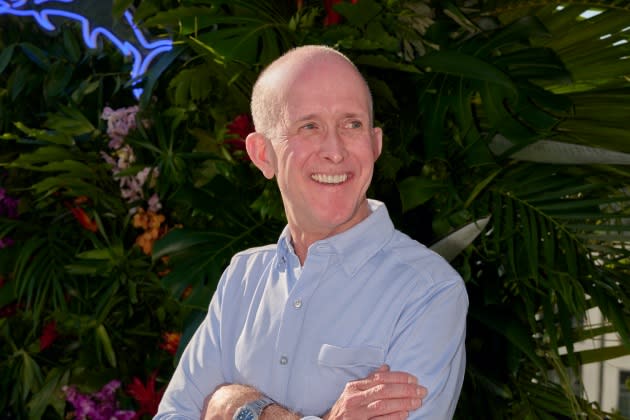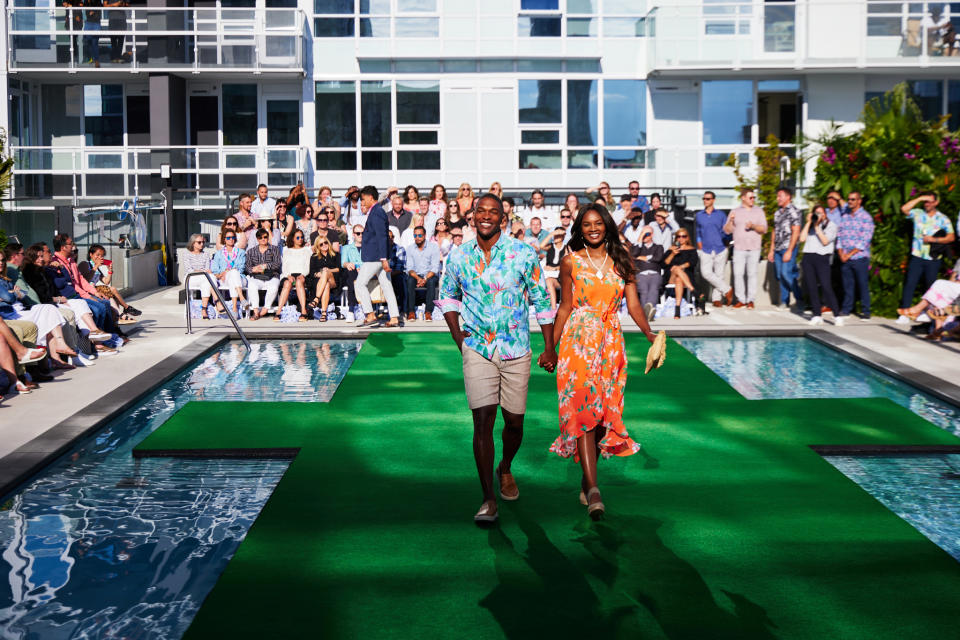Oxford Industries’ Transformation Started With Tommy Bahama Purchase
- Oops!Something went wrong.Please try again later.

The acquisition of Tommy Bahama was a literal game-changer for Oxford Industries.
The Atlanta-based company traces its roots to 1942 when Thomas, Sartain and Hicks Lanier, three Nashville, Tenn.-bred brothers who were searching for a World War II business venture, decided to purchase Oxford of Atlanta, a small men’s and boys’ shirt and slacks company.
More from WWD
Over the years, the brothers created a successful private label manufacturing business that serviced most of the major national retailers in the U.S. including J.C. Penney, Sears Roebuck and Montgomery Ward. In its heyday, the company owned and operated 45 domestic factories and another 14 offshore.
But by the 1990s, cheap offshore manufacturing had taken its toll on the business, which had gone public in 1960, resulting in declining sales and profits. It was at that point that then-chief executive officer J. Hicks Lanier, the second generation of the family to run the company, realized that in order to survive, Oxford would have to find another revenue source.
“If you go back to 1999, China had been admitted to the World Trade Organization, but wouldn’t be a full-fledged member until 2005,” said Thomas C. Chubb 3rd, who took over the CEO post when Lanier retired in 2012. “We knew the industry, from a manufacturing standpoint, was already migrating and when 2005 came along, it was just going to be like a tidal wave.”
So Chubb, who joined Oxford as a summer intern 32 years ago, and the executive team held a brainstorming session to strategize the company’s future path. “Our history had been about owning the needles,” he said. “But we knew, if we’re going to be successful going forward, we have to own the consumer.”
They looked to Polo Ralph Lauren as the perfect case study. “It doesn’t matter where production goes, or what happens in the department store world,” he said. “The consumer loyalty is to Polo.”
So Oxford started to search for a brand that fit the bill. “During that strategic planning session, we came up with a list of around 50 names of brands that we would be interested in. One of them was Tommy Bahama. And they actually came on the market later that year.”
Oxford opened discussions and came close to making a deal, but when the financing market dried up in 2000, it was forced to pull back and Tommy Bahama sold a minority interest to a private equity firm, Saunders, Karp & Megrue.
But by 2001, the PE firm was searching for someone to “professionalize the business,” Chubb said, and hired Doug Wood, the now-CEO. “The founders are just incredible guys, but bringing in a guy like Doug, who’s a very hard-nosed business” was the beginning of the brand’s transformation. Oxford reentered the picture and in June 2003 purchased Tommy Bahama in a deal worth $240 million in cash, $10 million in stock, and up to an additional $75 million in contingency payments.
“If you look back at fiscal 2003, the last year before we owned Tommy Bahama,” Chubb said, “we did $764 million in sales, our companywide gross margin was 20.7 percent and we made $1.34 a share. We were fighting for nickels and dimes.”
He added, “That purchase was a huge deal for us. If it had blown up on us, it could have been a fatal blow. But as Hicks said at the time, the only thing scarier than doing it was not doing it. We knew that our historical business model just was not going to be very successful going forward.”
The purchase of Tommy Bahama really set into motion the reinvention of Oxford Industries, which has since added Lilly Pulitzer, Southern Tide, the Beaufort Bonnet Company and Duck Head to its stable of brands. The last vestige of its former self was shed last year when it exited its Lanier Apparel tailored clothing manufacturing division.
“A lot of companies have a hard time moving past their history,” Chubb said. “But we didn’t get so mired in our heritage that we couldn’t move forward.”
Today, Tommy Bahama represents the largest brand in Oxford’s portfolio with sales last year of $724 million, 7 percent ahead of the post-pandemic results of 2019. Lilly Pulitzer is the next largest with $299 million in sales, followed by Southern Tide at $54 million. The other “emerging” brands accounted for around $40 million.
Chubb estimated the Tommy Bahama will hit $850 million in sales this year and will continue to be Oxford’s largest asset. “The other brands have great growth potential, but Tommy is unique,” he said. “What we’re selling in Tommy is the island life dream, one that appeals to the American psyche in a very strong way. So it’s a very, very powerful brand message. Even if they’re getting on the subway in New York, or grinding through traffic in Atlanta, people just love the mental place that takes them. And we do such an incredible job of bringing that to life through our products, our retail stores, our restaurants and our e-commerce. So I think the potential for Tommy Bahama is big and there is still tons of room to grow.”
He pointed to the newfound strength of the women’s business — a market that is about twice the size of the men’s market — as a key catalyst to that growth. “To be in sync with the market, we’d have to be two-thirds women’s and one-third men’s, so as big as our men’s business is, women’s is going to be bigger just based on that.”
Add to that the other categories the brand has embraced such as furniture and spirits, and Chubb believes the sky’s the limit.
Decades ago, for a manufacturing company to be successful, it had to get sold at the major department stores. But the climate is different now and a brand needs to have its own direct-to-consumer presence, “because the primary method of discovery” today is digital, Chubb said. And having a strong online presence also helps the brick-and-mortar stores.
“That’s an area where I think Tommy Bahama has gotten much more adept in the last couple of years, and has a lot of room still to go,” he said.
In addition to Tommy Bahama, Oxford has concentrated on owning and operating what Chubb refers to as other “happy brands.”
“That’s what people want, right? Happiness is an emotion and if we’re just appealing to the mind, then we’re just selling product and competing with every other brand in the world. But we want to make people feel good, and based on the feeling, sell them the product.”
Chubb said that while Tommy Bahama’s product is “second to none” with its “easy fits and luxurious fabrics,” by appealing to emotion, it establishes a “tribal loyalty. We’re aiming for the heart, not the head.”
The other brands evoke emotions as well, all of which are slightly different. Lilly Pulitzer is rooted in the colorful, Palm Beach-inspired bohemian chic lifestyle; Southern Tide connects with the Southern coast, and Beaufort Bonnet is about a charmed childhood. Duck Head, a traditional Southern brand whose history dates back to 1865, has had a variety of owners over the years and was acquired by Oxford in 2016. Although the brand is small — Chubb projected it’ll do $10 million this year — it is profitable and “growing rapidly. It’s got massive potential.”

Courtesy of Tommy Bahama
Looking to the future, Chubb said Oxford is “always looking to add happy brands” to its portfolio. The company is structured into an emerging brands group, which houses Beaufort Bonnet, Duck Head and Southern Tide, and this “gives us a great platform to bring in a smaller, earlier-stage brand,” he said.
“Seven or eight years ago, we would tell people this, if it’s not $50 million in sales, we’re not interested, because it’s not big enough to move the needle for us. But then we realized that so much of the action in the industry these days is with the smaller brands because people love to discover these more unique, smaller brands.
“At the same time, we would still love to do a bigger transaction too — maybe not Tommy Bahama size, but something to move the needle,” he said. “We would love to do something with a brand with sales in the $100 million range, but we know there are not a ton of those out there. And we don’t want to do a deal just to do it, we would need to find a brand that has the same values, with a management team that is very much aligned with ours. And we’ve got the financial wherewithal to do that.”
Sign up for WWD's Newsletter. For the latest news, follow us on Twitter, Facebook, and Instagram.

